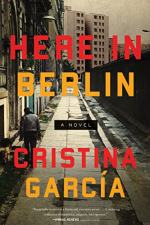|
This section contains 811 words (approx. 3 pages at 400 words per page) |

|
Here in Berlin Summary & Study Guide Description
Here in Berlin Summary & Study Guide includes comprehensive information and analysis to help you understand the book. This study guide contains the following sections:
This detailed literature summary also contains Quotes and a Free Quiz on Here in Berlin by Cristina Garcia.
The following version of this book was used to create this study guide: Garcia, Cristina. Here in Berlin. Berkeley: Counterpoint, 2017.
Here in Berlin opens on a character referred to as the Visitor as she arrives in Berlin, unsure of precisely why she has come and feeling lonely and isolated. She begins taking long walks around the city and speaking with various Berliners, most of whom recollect the hardships they faced at the end of World War II and the years that followed. Though it is not stated outright, the novel seems to take place in the early 2000s.
In Part I, the Visitor speaks to a man who remembers the dilapidated state of the Berlin Zoo after repeated bombings, a man who was kidnapped from the shores of Cuba by Nazi naval forces, and a Jewish woman whose husband arranged for her to hide in a sarcophagus when the war broke out. Another woman discusses her life's work defending Nazis for war crimes, and a former nurse tells a horrifying tale about being ordered to administer lethal injections to Jews and wounded soldiers. In a lighter story called “Dance Craze,” a former East German Stasi agent recalls his time working for the Ministry of Culture, by whom he was asked to invent a dance to rival those popular in the West in the 1960s and encourage loyalty to the Communist Party in the youth of the German Democratic Republic.
In Part II, the Visitor meets with a friend referred to as A., who is a Cuban-American as she is. They discuss their pasts and their mutual problems with their “unbearable mothers” (59). The Visitor then speaks to the owner of a Nazi-themed sex club who contends that she herself is not a Nazi, and that she is merely “defending people's rights to their memories, their histories, their fantasies” (62). Next, a South African eye doctor works on a patient who recalls the end of the war when she was forced into prostitution to support herself. The former captain of a Nazi-sponsored cruise ship recalls his devastating experience aboard the ship when it was hit by a Soviet torpedo and began to sink. Though the captain tried to save his passengers, the survivors mostly consisted of Nazi officers who were, no doubt, given first access to the lifeboats. A historian tells the Visitor about her grandfather, a Spanish soldier fighting for the Nazis who died defending the Reichstag as the Russians stormed Berlin, and a Vietnamese immigrant narrates a disturbing story about being raped by her boss at a munitions factory. In a chapter titled “Amnesia,” a former photojournalist tells the Visitor he has lost his memory after an apparent attempted suicide, and contrasts his affliction to the state of the city itself, which is “intent on expunging its past” (98) but incapable of doing so.
In Part III, the Visitor continues to struggle with her own loneliness, and speaks to a man who was sent to the United States by the Nazi Ministry of Propaganda to study and report back on the rhetorical stylings of African-American preachers. A woman recalls her disturbing experience in a Nazi breeding program, and a former Luftwaffe pilot speaks bitterly about returning from the war to find that his countrymen, ashamed at Germany's loss, wanted nothing to do with him. A former dancer tells the Visitor about performing for Hitler as a ballerina and then having her foot crushed in a freak accident at a dance club. The dancer reinvented herself in the modern style, a form the Germans appreciated after the war for the feelings of “catharsis” (135) it inspired. Next, in three interconnected stories, individuals reflect on their familial links to concentration camps, including a woman whose parents worked at Sachsenhausen and, she insists, were “just trying to survive in difficult times” (144).
Part IV tells the stories of a former actor in Nazi propaganda films who is losing his sight, and a former volcanologist who has never recovered from losing the love of his life in Chile during the regime of dictator Augusto Pinochet. A woman sits beside her comatose lover's hospital bed and tells the Visitor of their experience as signal operators for the Russian Army in Berlin at the end of the war. A former Stasi agent recalls posing as a punk rock musician to inform on members of the counterculture, and a recently retired clarinetist for the Berlin Philharmonic tells the Visitor of his father's suicide when the Russians were closing in, and how this trauma has haunted him all his life.
In the epilogue, the Visitor's daughter arrives in Berlin and the two women go sightseeing together. The Visitor learns that her own mother has recently died, and she feels at peace for the first time in recent memory. She feels she has discovered a calling while collecting these stories.
Read more from the Study Guide
|
This section contains 811 words (approx. 3 pages at 400 words per page) |

|



